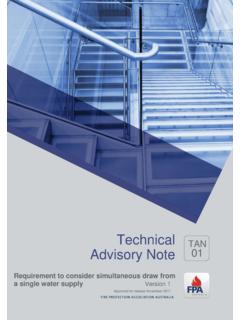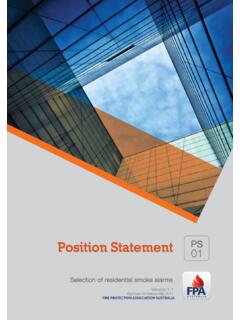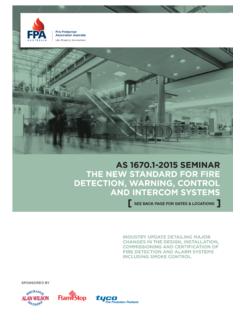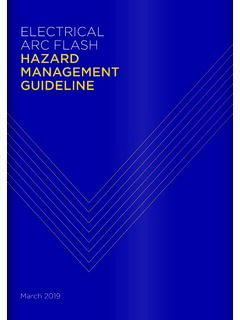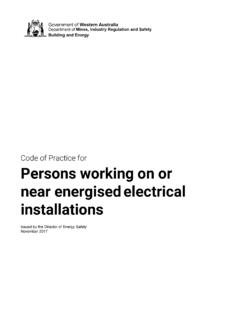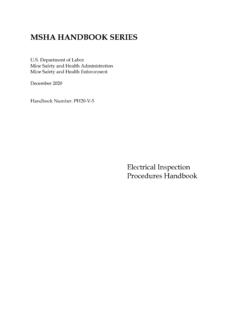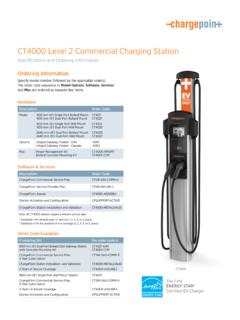Transcription of Section 6 Fire Detection and Alarm Systems
1 Section 6 fire Detection and Alarm Systems Russell Porteous Chief Executive Officer Firewize Services Section 6 of AS1851-2012 covers: fire Detection and Alarms Systems electrical Detection and Control Systems for: Special Hazards Systems ; and Smoke Hazard management Systems Smoke and Heat Alarms Emergency Warning Systems Emergency Intercom Systems Occupant Warning Systems Section 6 fire Detection and Alarm Systems General Information Prevent adversely affecting the normal operation of any system , except for those Systems to be serviced. Inform responsible person on-site that activities may adversely affect the occupants or operations of the building. Inform the responsible entity of the expected duration of the impairment so that alternative safety arrangements can be implemented Notify the monitoring service provider where testing or service may cause signals to be transmitted. This could include configuring the Alarm signalling equipment to test mode and confirm normal operation at completion Section 6 fire Detection and Alarm Systems Precautions Impedance Distinctly Audible Section 6 fire Detection and Alarm Systems Definitions Baseline Data Is the capturing of system design and performance requirements.
2 For fire Detection and Alarm Systems it should include: Systems interface diagram A statement detailing the design Standard of the system , including date of publication and any approved exceptions Documentation required by the approved design such as commissioning documentation as detailed in the relevant system design, installation and commissioning Standard Date of initial system installation. Cause and effect statement for each system interface function. Section 6 fire Detection and Alarm Systems Baseline Data C3 EXAMPLE OF fire Alarm system BASELINE DATA The following are examples of baseline data information: . Baseline Data ( ) system quiescent current. system full Alarm current, including warning system load. Nominal battery capacity fitted. Required battery capacity. Battery manufacture date. Installation date of fitted battery. Load current of each ancillary circuit. Amplifier rated output; impedance ( ) and power (W).
3 Measured impedance ( ) and power load (W) of each loud speaker circuit. Section 6 fire Detection and Alarm Systems Baseline Data C3 EXAMPLE OF fire Alarm system BASELINE DATA The following are examples of baseline data information: . Section 6 fire Detection and Alarm Systems Routine Service Frequency and Table References system / Equipment Monthly 6 Monthly Yearly 5 Yearly fire Detection and Alarm Systems Occupant Warning Systems Special Hazards Systems CIE Smoke Hazard Systems CIE Emergency Warning system Emergency Intercom Systems Monthly Routine Service Schedule fire Detection and Alarm system , Special Hazard Systems and Smoke Hazard management Systems Section 6 fire Detection and Alarm Systems Table Section 6 fire Detection and Alarm Systems Table Item No. Item Action required and pass/fail requirement External Alarm INSPECT the external Alarm (bell or strobe light) to ensure it clearly indicates the designated building entry point.
4 Inspect to ensure the external Alarm label is legible with the word fire in characters not less than 25 mm in height. Control and indicating equipment (CIE) INSPECT the following as applicable: fire indicator panel (FIP), sub-indicator panel (SIP), repeater panel, fire brigade panel (FBP), mimic panel, fire fan control panel (FFCP) and (a)ensure that they are clearly visible, readily accessible and free from dust and contaminants; and (a)where a panel is obscured by a door, check that the door is correctly labelled. Where manual call points use replaceable frangible elements, ENSURE that at least one replacement element and tool are available for replacing the element where required. Battery enclosure Where vented batteries are used, INSPECT the battery enclosure for evidence of corrosion. fire Alarm SIMULATE an Alarm condition and confirm that all required common or general visual and audible indications operate and the external Alarm is activated.
5 Where the system is monitored ensure the Alarm has activated the Alarm signalling equipment. Where CIE is a sub- indicator panel, confirm that the Alarm condition is indicated at the FIP. Occupant warning system SIMULATE an Alarm and confirm the Alarm initiates the occupant warning system including any visual warning devices (VWD). Isolate/Disable INITIATE an isolate/disable condition at the fire indicator panel and confirm that all required common or general visual and audible indications operate. Where the system is monitored, ensure the isolate is received by the monitoring service provider Alarm signalling equipment. Where the panel is an SIP, confirm that the isolate/disable condition is indicated at the FIP as either a fault or isolate/disable. Section 6 fire Detection and Alarm Systems Table Item No. Item Action required and pass/fail requirement External Alarm INSPECT the external Alarm (bell or strobe light) to ensure it clearly indicates the designated building entry point.
6 Inspect to ensure the external Alarm label is legible with the word fire in characters not less than 25 mm in height. Control and indicating equipment (CIE) INSPECT the following as applicable: fire indicator panel (FIP), sub-indicator panel (SIP), repeater panel, fire brigade panel (FBP), mimic panel, fire fan control panel (FFCP) and (a)ensure that they are clearly visible, readily accessible and free from dust and contaminants; and (a)where a panel is obscured by a door, check that the door is correctly labelled. Where manual call points use replaceable frangible elements, ENSURE that at least one replacement element and tool are available for replacing the element where required. Battery enclosure Where vented batteries are used, INSPECT the battery enclosure for evidence of corrosion. fire Alarm SIMULATE an Alarm condition and confirm that all required common or general visual and audible indications operate and the external Alarm is activated.
7 Where the system is monitored ensure the Alarm has activated the Alarm signalling equipment. Where CIE is a sub- indicator panel, confirm that the Alarm condition is indicated at the FIP. Occupant warning system SIMULATE an Alarm and confirm the Alarm initiates the occupant warning system including any visual warning devices (VWD). Isolate/Disable INITIATE an isolate/disable condition at the fire indicator panel and confirm that all required common or general visual and audible indications operate. Where the system is monitored, ensure the isolate is received by the monitoring service provider Alarm signalling equipment. Where the panel is an SIP, confirm that the isolate/disable condition is indicated at the FIP as either a fault or isolate/disable. Section 6 fire Detection and Alarm Systems Table Item No. Item Action required and pass/fail requirement External Alarm INSPECT the external Alarm (bell or strobe light) to ensure it clearly indicates the designated building entry point.
8 Inspect to ensure the external Alarm label is legible with the word fire in characters not less than 25 mm in height. Control and indicating equipment (CIE) INSPECT the following as applicable: fire indicator panel (FIP), sub-indicator panel (SIP), repeater panel, fire brigade panel (FBP), mimic panel, fire fan control panel (FFCP) and (a)ensure that they are clearly visible, readily accessible and free from dust and contaminants; and (a)where a panel is obscured by a door, check that the door is correctly labelled. Where manual call points use replaceable frangible elements, ENSURE that at least one replacement element and tool are available for replacing the element where required. Battery enclosure Where vented batteries are used, INSPECT the battery enclosure for evidence of corrosion. fire Alarm SIMULATE an Alarm condition and confirm that all required common or general visual and audible indications operate and the external Alarm is activated.
9 Where the system is monitored ensure the Alarm has activated the Alarm signalling equipment. Where CIE is a sub- indicator panel, confirm that the Alarm condition is indicated at the FIP. Occupant warning system SIMULATE an Alarm and confirm the Alarm initiates the occupant warning system including any visual warning devices (VWD). Isolate/Disable INITIATE an isolate/disable condition at the fire indicator panel and confirm that all required common or general visual and audible indications operate. Where the system is monitored, ensure the isolate is received by the monitoring service provider Alarm signalling equipment. Where the panel is an SIP, confirm that the isolate/disable condition is indicated at the FIP as either a fault or isolate/disable. 6 Monthly Routine Service Schedule fire Detection , Alarms and Controls for Special Hazard Systems Section 6 fire Detection and Alarm Systems Table Section 6 fire Detection and Alarm Systems Table Item No.
10 Item Action required and pass/fail requirement External Alarm INSPECT the external Alarm (bell or strobe light) to ensure it clearly indicates the designated building entry point. Inspect to ensure the external Alarm label is legible with the word fire in characters not less than 25 mm in height. Control and indicating equipment (CIE) INSPECT the following as applicable: fire indicator panel (FIP), sub-indicator panel (SIP), repeater panel, fire brigade panel (FBP), mimic panel, fire fan control panel (FFCP) and (a)ensure that they are clearly visible, readily accessible and free from dust and contaminants; and (a)where a panel is obscured by a door, check that the door is correctly labelled. Where manual call points use replaceable frangible elements, ENSURE that at least one replacement element and tool are available for replacing the element where required. Battery enclosure Where vented batteries are used, INSPECT the battery enclosure for evidence of corrosion.
